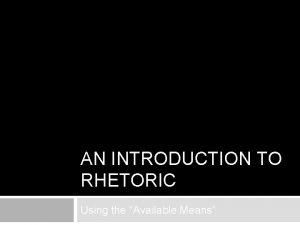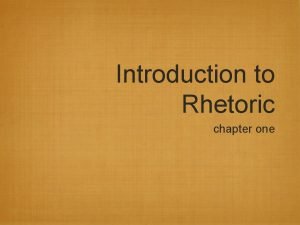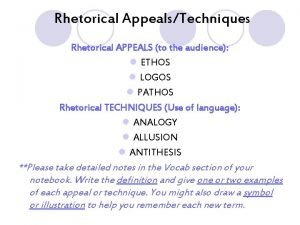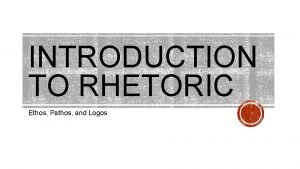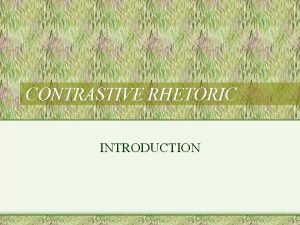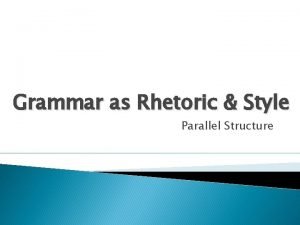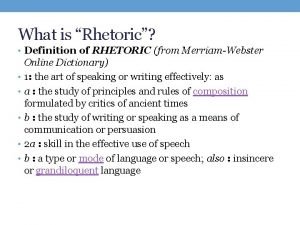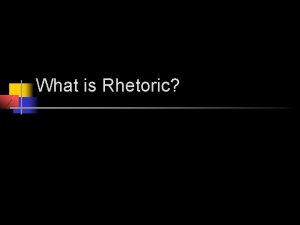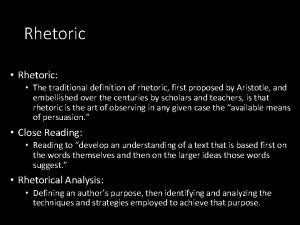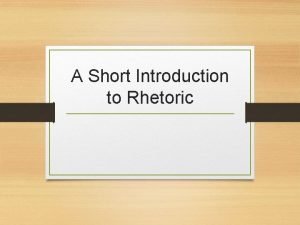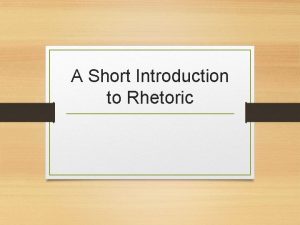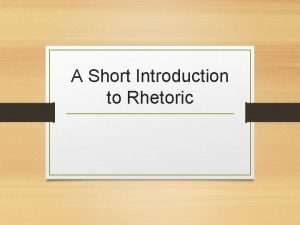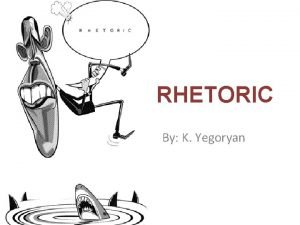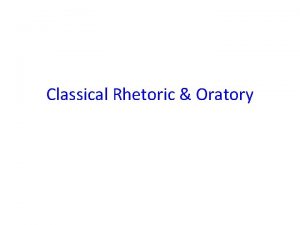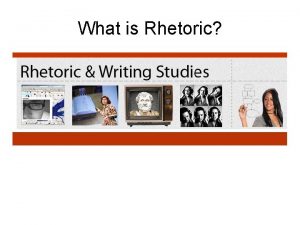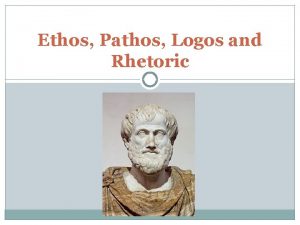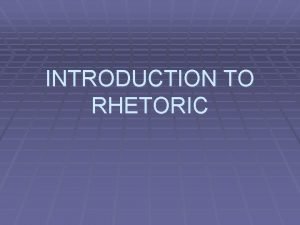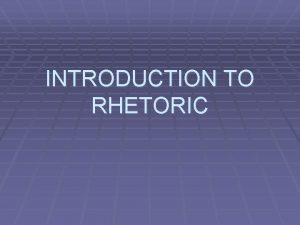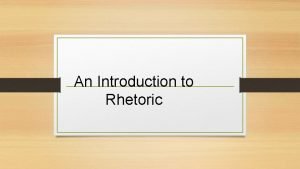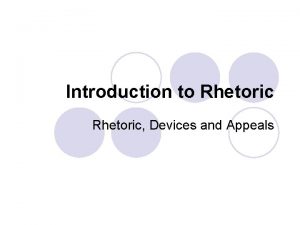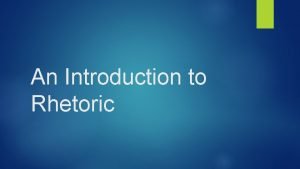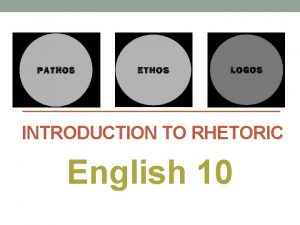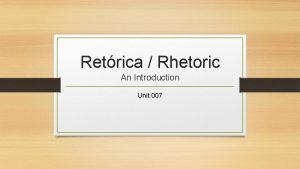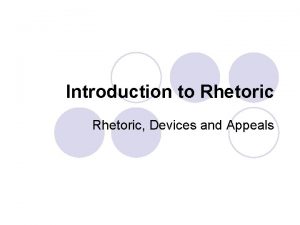Introduction to Rhetoric chapter one Rhetoric definition the



























- Slides: 27

Introduction to Rhetoric chapter one

Rhetoric *definition: the faculty of observing in any given case the available means of persuasion *rhetoric is always situational-it has: context-the occasion or time and place it was written or spoken purpose- a goal the speaker/writer wants to achieve *identifying both is essential to analyzing rhetoric **Also-keep in mind BIAS-sometimes context can be influenced by current events/cultural bias

The Rhetorical Triangle an effective writer/speaker knows his audience and subject--all three parts are inter-connected skilled writers/speakers must consider this interaction when developing a text/speech ** keep in mind-a PERSONA may come into play-the character the speaker creates when he/she writes or speaks

Important Effective Rhetoric has a clear main idea/thesis/claim/assertion

ETHOS appeal to “character” to demonstrate that speaker/writer is credible and trustworthy. It also shows expertise/knowledge-expertise/training-sincerity-or a combination of these ETHOS may: emphasize shared values between speaker and audience rely on speaker’s reputation be established through discourse itself-by making a good impression include a tone of reason and goodwill

LOGOS appeal to reason with logical ideas *means having a clear main idea/thesis with specific details, examples, facts, statistics, data and/or expert testimony * may acknowledge a counter argument-to anticipate opposing views/objections. This removes the vulnerability that comes with ignoring the argument.

Acknowledging a counter-argument you agree that a counter-argument may be true and then deny all or part of the argument CONCEDE (agree) REFUTE (deny)

Pathos appeal to emotions that often uses vivid description and figurative language writing that ONLY uses this appeal is often propagandistic and is rarely effective for the long term

Visual Rhetoric not verbalized-only an image may use more than one appeal may be satiric in nature-but doesn’t have to be EX: political cartoons

visual rhetoric

visual rhetoric

Rhetoric in literature Authors need to be aware of appeals in order to create effective characters and story lines

Classic Model of Rhetoric INTRODUCTION (exordium): introduces the reader to the subject under discussion often establishes ethos draws reader into the text by piquing interest, challenging them or getting attention

Classic Model cont. . . NARRATION (narratio): may provide factual information and background material on subject may explain why the subject is a problem that needs addressing appeals are usually logos and pathos

Classic Model cont. . CONFIRMATION (confirmatio) development of the proof needed to make the writers case the most specific and concrete detail in the text generally-strongest appeal to logos

Classic Model cont. . . REFUTATION( refutatio): addresses the counter used to be only at the end of an argument-to anticipate objections BUT-can also come early if the writer/speaker knows that the audience holds opposing views usually appeals to logos

Classic Model cont. . . CONCLUSION (peroratio): in one paragraph or several-author brings the essay to a close usually appeals to pathos and reminds audience of previously established ethos should not focus on repetition, but in bringing together all the ideas of the essay last words and ideas of a text are usually what the audience remembers

Patterns of development Arrangement of essays is often done by the purpose of the essay The following slides will address the major patterns of development seen in essays

Narration refers to telling a story or recounting events May be based on personal experience or knowledge gained from reading/observation includes: concrete detail, POV, sometimes dialogue crafting a story that supports a thesis

Description closely allied with narration because it also includes specific details is different because it emphasizes the senses(looks, sounds, smells, tastes, feels) by painting a picture often used to establish a mood-rarely an entire essay is description makes it easy for readers to empathize with you

process analysis explains how something works, how to do something or how something was done the key is claritytransitions that mark the sequence of major steps, stages or phases of the process

exemplification provides a series of examples-facts, specific cases or instances-to turn a general idea into a concrete one relies on Aristotles’ idea of induction: examples are a type of logical proof a writer may use several examples or one long extended example to prove his/her point

comparison/contrast juxtaposing two things to highlight their similarities and differences used to analyze information carefully and often reveals insights into the nature of the information being analyzed may be organized in two ways: subject by subject-discusses all the elements of one subject and then turns to another Point-by-point- organized around the specific points of a

classification and division essay helps readers make connections between things that might otherwise seem unrelated writer develops his own categories to break down a larger idea into parts like other Arrangements- entire essay does not have to be all classification and division

DEFINITION so many discussions depend upon definition-to ensure writers and audiences are speaking the same language, definition may lay the foundation to establish common ground or establish areas of conflict Definition may be part or all of the essay

cause and effect analyzing causes that lead to a certain effect or the effects that result from a cause is a powerful foundation for argument it is important to trace a chain of cause and effect and recognize contributing causes-you do not want to jump to conclusions that there is only one cause or one result-nor do you want to mistake an effect for an underlying cause often signaled by a WHY in the title or opening paragraph

When Rhetoric misses the Mark whether a speech or essay is effective rhetoric is often opinion Not every attempt at rhetoric hits mark
 An introduction to rhetoric using the available means
An introduction to rhetoric using the available means How is rhetoric defined in this chapter
How is rhetoric defined in this chapter Ethos rhetoric definition
Ethos rhetoric definition Rhetorical triangle speaker audience message
Rhetorical triangle speaker audience message Logos rhetoric definition
Logos rhetoric definition Contrastive rhetoric definition
Contrastive rhetoric definition Parallel structure rhetorical definition
Parallel structure rhetorical definition What is rhetoric
What is rhetoric One god one empire one emperor
One god one empire one emperor One one one little dog run
One one one little dog run One king one law one faith
One king one law one faith One empire one god one emperor
One empire one god one emperor One team one plan one goal
One team one plan one goal See one do one teach one
See one do one teach one One price policy
One price policy Willow cabin speech
Willow cabin speech See one do one teach one
See one do one teach one Asean tourism strategic plan
Asean tourism strategic plan One vision one identity one community
One vision one identity one community Hình ảnh bộ gõ cơ thể búng tay
Hình ảnh bộ gõ cơ thể búng tay Slidetodoc
Slidetodoc Bổ thể
Bổ thể Tỉ lệ cơ thể trẻ em
Tỉ lệ cơ thể trẻ em Gấu đi như thế nào
Gấu đi như thế nào Tư thế worm breton
Tư thế worm breton Hát lên người ơi
Hát lên người ơi Các môn thể thao bắt đầu bằng tiếng đua
Các môn thể thao bắt đầu bằng tiếng đua Thế nào là hệ số cao nhất
Thế nào là hệ số cao nhất
